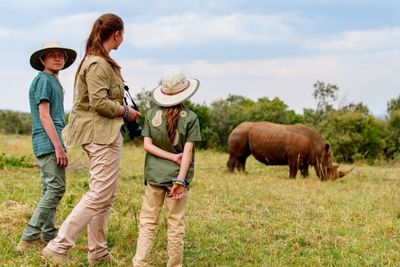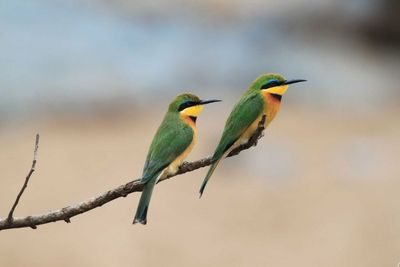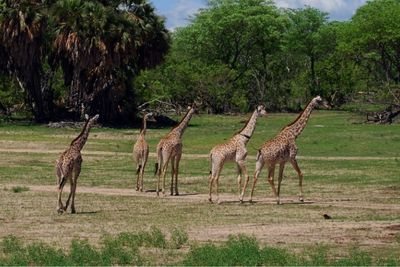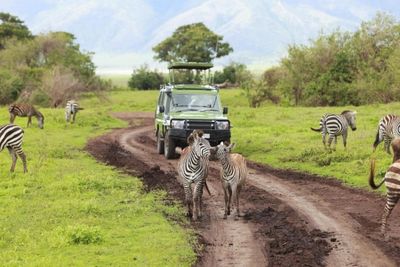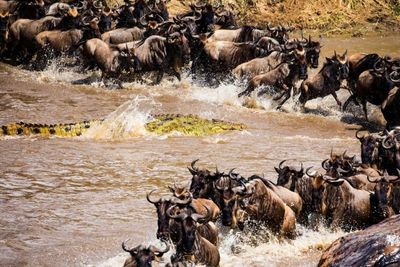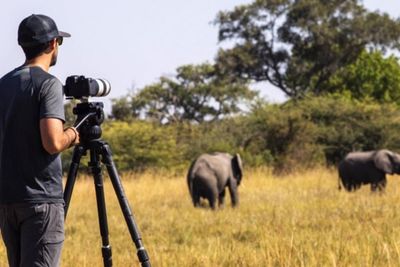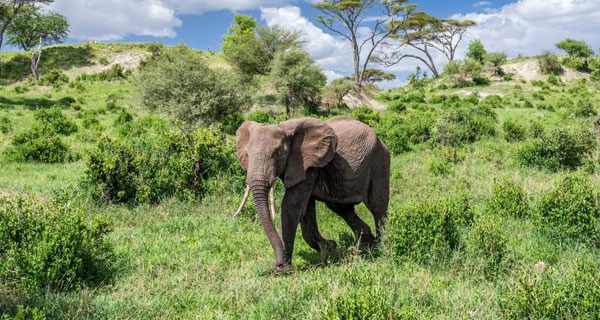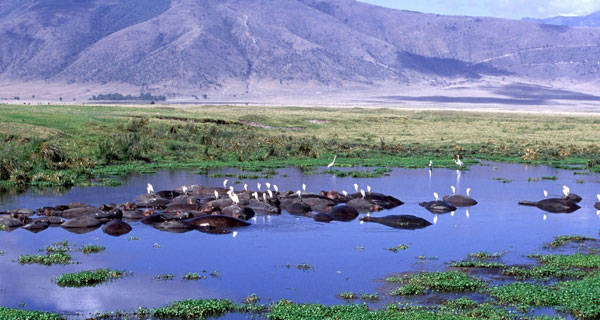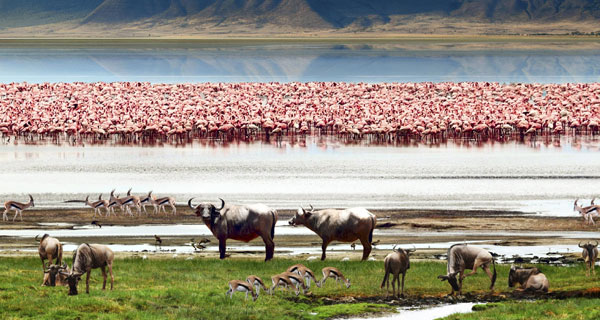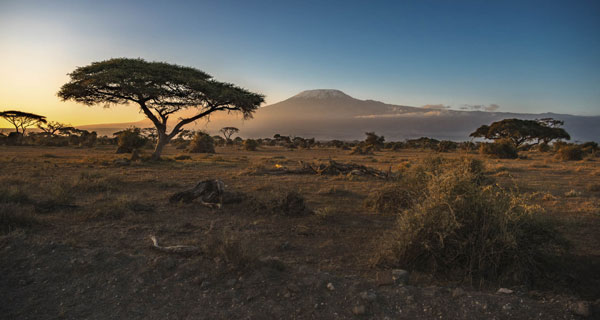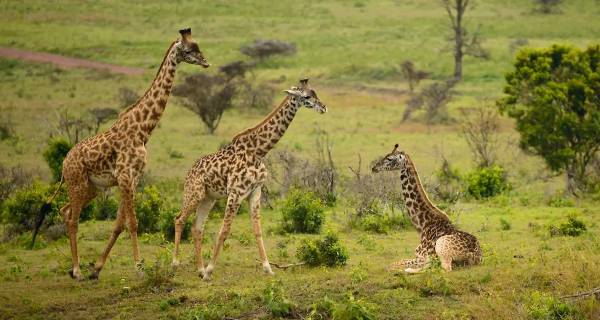Serengeti National Park is a one-of-a-kind destination where you can experience the Great Wildebeest Migration. You’ll explore diverse ecosystems, and see the iconic Big Five on Serengeti Safari. The wide-open grasslands, dotted with acacia trees, provide stunning views. Even, the sunsets here leave a lasting impression. It’s perfect for wildlife and nature lovers.
Let's Plan Tanzania
Serengeti National Park
Serengeti National Park is a world-renowned wildlife haven in Tanzania, famed for the Great Migration and abundant big game. Vast plains, dramatic sunsets, and unforgettable safari experiences await. Discover lions, elephants, and more in their natural habitat across one of Africa’s most iconic and breathtaking landscapes.
Discover Holidays to Serengeti
An African Safari perhaps feels incomplete without visiting the Serengeti National Park in Tanzania. This vast expanse is the backdrop of one of the astonishing spectacles of natural earth – the Great Migration.
The national park spans nearly 15,000 square kilometres and is teeming with wildlife. The area is home to over 2 million ungulates, 4,000 lions, 1,000 leopards, 550 cheetahs, and around 500 different bird species.
This delicate ecosystem features landscapes peppered with acacia trees and rocky kopjes where lions often perch to survey their territory. Meanwhile, elusive leopards hide in the dense riverine forests.
For a spectacular panoramic view, consider a hot air balloon ride at sunrise to see the park from above during Safari in Tanzania. Additionally, there are game drives and walking safaris that allow you to experience the park’s iconic wildlife up close. Doesn’t matter if you aspire for a classic safari drive or a quiet evening under the stars, Serengeti has got everything for its admirers.

Welcome to Tanzania! We’re excited to share our home with you. Every single day on a Safari in Tanzania is a delightful experience here. Travelling in the country provides sights that will awe and inspire you.
Juma Rajabu Sumbi
Managing Director
Why Visit Serengeti?
Wildlife in Serengeti










Visiting Tanzania’s Serengeti National Park means getting up close with some of the most amazing wildlife on Earth. There’s so much to see, from the Big Five to smaller animals that make the park unique.
The Big Five
These are the stars of our Safari Tour in Tanzania—lions, elephants, rhinos, leopards, and buffalos. Lions are often found resting in groups, while leopards hide in trees. Elephants move in herds, and buffalos hang out near water. Rhinos, though rare, are a special sight.
Other Wildlife
Serengeti is also famous for the Great Wildebeest Migration, where millions of wildebeest and zebras roam the plains. You’ll also see giraffes, cheetahs, hyenas, and hippos in the rivers.
Birdlife
With more than 500 species, the park is a birdwatcher’s dream. Look out for the colourful Fischer’s lovebirds and kori bustards.
Insects
From dung beetles to butterflies, even the tiniest creatures have an important role here.Exploring the wildlife in Serengeti National Park is a thrilling experience that never disappoints. There’s always something incredible around the corner!
When to go to Serengeti
January
During January, Tanzania’s Serengeti National Park transforms into a verdant oasis, offering clear skies and optimal conditions for wildlife observation.
The Ndutu Plains are particularly lush, becoming a haven for elephants, giraffes, and various antelopes.
This month is ideal for those setting on Tanzania Safari Holidays, offering photographers and nature enthusiasts the chance to capture serene beauty and vibrant wildlife interactions.
February
February in the Serengeti is marked by the wildebeest calving season, a highlight of the Best Tanzania Safari Tours.
The plains teem with newborns, attracting numerous predators and providing dramatic wildlife viewing opportunities.
This spectacle, part of the Great Migration, offers an unforgettable experience for those on a Luxury Tanzania Safari, witnessing the raw beauty of life on the Serengeti plains.
March
As the green season concludes, March in Serengeti National Park sees the onset of long rains, which bring renewal and fewer crowds.
Visitors can witness the migratory herds begin their westward journey in a more intimate setting.
This period offers a unique opportunity for those looking for Tanzania luxury safaris to enjoy quieter conditions and competitive accommodation rates.
April
April’s Serengeti experiences fewer visitors due to the rainy season, characterized by increased humidity and wet conditions.
This month presents a unique opportunity for adventurers on a Tanzania safari looking to explore the less-travelled areas of the park. The lush, rain-drenched landscapes offer a tranquil and picturesque safari experience, distinct from the usual dry season visits.
May
May brings significant rainfall to the Serengeti, resulting in a quieter ambience at the park’s camps and lodges.
During this month, those who choose Tanzania safari packages have a unique chance to experience the park under wet conditions.
Adventurous travellers can track the Great Migration Serengeti through the central and western regions, witnessing firsthand the wildlife’s dramatic survival tactics. This time showcases nature’s resilience and offers a profound perspective on the Serengeti’s life cycle.
June
June heralds the beginning of the dry season in the Serengeti, creating ideal conditions for wildlife viewing.
During this time, the Great Migration advances northward, and the increasingly dry landscape improves visibility for observing wildlife.
Visitors might also enjoy occasional dramatic afternoon thundershowers, which bring a refreshing twist to the safari. These elements combine to enhance what many consider the Best Safari Tanzania has to offer.
July
From July to September, the Serengeti witnesses the peak of the Great Migration’s dramatic river crossings, drawing attention from around the world.
July stands out as especially exciting, with predators hunting the vulnerable herds as they cross the rivers.
This spectacle is an important experience for anyone looking to witness the intense and natural drama of the Serengeti. It displays the raw and unfiltered wildness that Tanzania’s Serengeti tours are famous for.
August
August marks the peak season for watching the intense river crossings in the northern Serengeti, as the migration heads into the Masai Mara.
This month features thrilling predator-prey interactions that capture the attention of visitors.
It’s one of the best times for wildlife viewing, with clear skies and large herds navigating through dangerous, crocodile-filled waters. These elements make the journey an unforgettable spectacle for anyone visiting the Serengeti.
September
In September, visitor activity is high, especially near the Kenyan border where the Mara River is a key spot for migration.
The northern parts of the Serengeti are very busy during this time. However, the southern areas are much quieter, providing a more peaceful Tanzania Safari Experience.
This allows for close-up wildlife sightings and time for visitors to enjoy and reflect on the natural beauty around them.
October
As October ends the dry season, the Serengeti plains begin to dry up but still provide excellent wildlife viewing.
Animals gather at the remaining water sources, creating perfect conditions for observing them.
This gathering is ideal for game-watching as the herds get ready to migrate toward Kenya. These conditions enhance the value of Tanzania safari packages during this transitional time.
November
November brings the short rains to the Serengeti, revitalizing the southern grasslands.
This quieter season is ideal for those looking to enjoy the Serengeti’s refreshed landscapes and take advantage of lower Tanzania safari costs.
The park’s transformation during this time provides a new perspective on the ever-changing Serengeti ecosystem.
December
December witnesses the Great Migration herds returning to the southern plains of the Serengeti for the breeding season.
The park’s scenery shifts as temperatures and humidity rise, heralding the wet season.
This busy month requires early bookings to ensure a spot during the festive season, offering a vibrant end to the annual migration cycle and marking the best time to visit Tanzania.
Things To Do In Serengeti
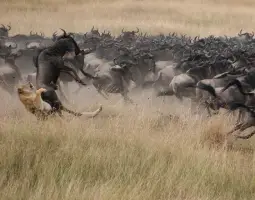
Great Migration Marvels
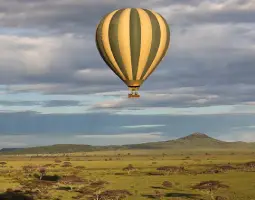
Balloon Safaris Above

Thrilling Game Drives
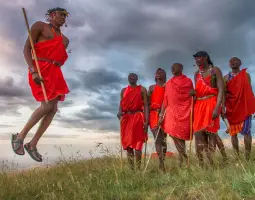
Cultural Village Visits
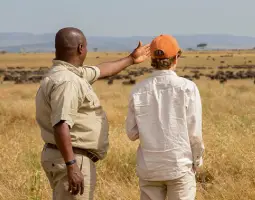
Guided Walking Safaris
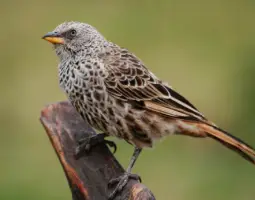
Serene Bird Watching
Design Your Serengeti Adventure
Select from expertly curated Serengeti safaris or customize your own, choosing properties that match every style and budget for your perfect trip.
Create your ideal Serengeti safari now!
Safari Packages
Create Your Dream Journey
Personalize your itinerary or choose from our curated travel experiences.
Talk to a Travel Expert
Receive expert advice to plan your ideal adventure with confidence.
Explore Tanzania with Us
Best Safari Packages In One Place
Arusha, Tanzania
Duration: 10 Days
Experience: Birding Safari
Price: On request
Arusha, Tanzania
Duration: 7 Days
Experience: Honeymoon Safari
Price: On request
Arusha, Tanzania
Duration: 16 Days
Experience: Birding Safari
Price: On request
Arusha, Tanzania
Duration: 13 Days
Experience: Northern Circuits
Price: On request
Arusha, Tanzania
Duration: 8 Days
Experience: Wildbeest Migration
Price: On request
Arusha, Tanzania
Duration: 21 Days
Experience: Best of Tanzania
Price: On request
Arusha, Tanzania
Duration: 7 Days
Experience: Maximum Wilderness
Price: On request
Why travel With Sumbi Extra Miles Safari?
LOCAL KNOWLEDGE
Our guides share local culture and hidden treasures because they are intimately familiar with Tanzania. A wonderful and genuine safari experience is guaranteed when you travel with a crew that is well-versed in every aspect.
TAILORED TRIP PLANS
Every trip is designed to fit your interests and travel style. Our personalized arrangements guarantee that you get the most out of your vacation, whether your goal is adventure or leisure.
ECO CONSCIOUS APPROACH
To preserve Tanzania's natural beauty, we place a high priority on sustainable methods. By selecting us, you contribute to responsible tourism and conservation initiatives, protecting wildlife and natural areas for coming generations.
All You Need to Know for Serengeti Safari Travel
Getting to Serengeti
Getting to Serengeti is easier than you might think, despite its remote location.
Most visitors start their Serengeti Safari journey from Kilimanjaro International Airport or Arusha.
From there, you can either take a short flight to one of the park’s airstrips or set on a scenic drive through Tanzania’s beautiful landscapes.
By Air:
Flights from Kilimanjaro or Arusha take 1-5 hours to reach the park’s airstrips.
By Road:
A drive-in safari from Arusha takes approximately 8 hours, with possible overnight stops at other parks along the way.
Access Gates:
Serengeti has four main entry gates: Naabi Hill, Ndabaka, Klein’s, and Bologonya.
Whether you choose to fly or drive, your Serengeti safari promises an unforgettable adventure. Combining both options offers the best of both worlds, giving you a chance to experience Tanzania’s diverse scenery as you make your way to the land of the Serengeti.
Serengeti National Park Fees 2024-2025
When visiting Serengeti National Park, paying park entry fees is essential. These fees contribute to the conservation of the park and its wildlife. The fees are categorized by age and season, with different rates for peak and low seasons. Here is a breakdown of Serengeti National Park Entrance Fees (per person per day):
Peak Season (16th May – 14th March)
- Adults (16+ years): $70
- Children (5-15 years): $20
- Children under 5 years: Free
Low Season (15th March – 15th May):
- Adults (16+ years): $60
- Children (5-15 years): $20
- Children under 5 years: Free
Please note that an 18% VAT is added to these fees. Additional charges apply for overnight stays, such as camping or lodging within the park.
These fees vary depending on the type of accommodation. Payments must be made via Mastercard, Visa, or TANAPA Smartcard, and fees are non-refundable.
Getting Around Serengeti National Park
At Sumbi, we offer Tanzania safari packages that make exploring Serengeti National Park an exciting adventure. Our experienced guides know the best routes and where to find amazing wildlife, so you can relax and enjoy every moment.
- Guided Safaris: We provide transportation, meals, and lodging, making your journey smooth and comfortable.
- Self-Drive: You can choose to rent a 4×4, but we recommend letting our guides handle the tricky terrain.
- By Air: We can arrange flights to various airstrips in the park, giving you quicker access to different regions.
When you are booking Tanzania Safari Packages with us, we handle all the logistics for you. From driving the park’s dirt roads to organizing your stay, we ensure your Serengeti adventure is memorable and filled with incredible wildlife encounters. Let us help you explore the Serengeti with ease!
Weather & Climate
Serengeti National Park has a tropical climate with changes depending on the time of year. The weather is usually pleasant but shifts between dry and wet seasons.
Dry Season (May to October)
Expect cooler days with little rain. Nights can be chilly, especially in higher areas.
Wet Season (November to April)
This is the warmer period, with regular rain showers that turn the landscape green. The most rain falls from March to May.
Temperature Range
During the day, temperatures range from 26°C to 30°C, while at night it can drop to around 15°C.
The climate of Serengeti National Park creates perfect conditions for viewing wildlife, including the famous Great Migration, making it a wonderful destination at any time of year.
Culture and Customs
When visiting Serengeti, you’ll not only experience incredible wildlife but also the rich culture of the Masai people, a semi-nomadic group living in the region.
Currency
The Tanzanian Shilling (TZS) is the official currency, though U.S. dollars are accepted in most places. Paying in shillings usually gives you a better rate.
Tipping
It’s common to tip safari guides and lodge staff. Plan to give $5 to $10 per day, and around 10% at restaurants.
The Masai People
The Masai are known for their bright clothing, beadwork, and unique traditions. You may meet them during your visit, and many are happy to share their culture.
Experiencing the customs and traditions of the Masai during your Serengeti Safari Trips offers a deeper connection to the region and its people, adding a cultural dimension to your wildlife adventure.
What to Eat
When you’re on a Serengeti safari with Sumbi Extra Miles Safari, meals are an important part of the experience.
Lodge Dining
If you’re staying at Serengeti House of Nature, you’ll be treated to a mix of local Tanzanian dishes like nyama choma (grilled meats) and ugali, along with some international favourites. You can even enjoy a special bush dinner under the stars.
Picnic Meals
For those busy exploring the park, we offer packed picnic meals so you can stop and eat while surrounded by the incredible wildlife.
Snacks and Supplies
If you’re camping, the park has stores where you can grab snacks, drinks, or even raw meats to cook up your meal at the campsite.
Every meal that you get on Serengeti Travel is thoughtfully arranged to improve your Serengeti safari. From lodge dining to picnic options, we ensure you enjoy every moment, including your mealtime, during your adventure.
How to Save Money in Serengeti
Visiting Serengeti National Park in Tanzania doesn’t have to be expensive. Here are some tips to help you save money while still enjoying a fantastic safari experience.
Join a Group Safari:
Instead of renting a car, join a group safari. These packages often include transport, accommodation, and meals, making it a more budget-friendly option.
Camp Instead of Lodging:
While there are luxury lodges, camping at one of the park’s campsites is a much cheaper alternative. Just make sure to get permission from TANAPA beforehand.
Pack Essentials:
Once inside the park, prices for basics like batteries or snacks can be high. Make sure to bring everything you might need before arriving.
By planning ahead and choosing the right options, you can enjoy Serengeti Safari Trips without overspending while still making the most of your adventure in the wild.
Essential Tips for Serengeti Safari
Planning a safari to Tanzania’s Serengeti National Park is an exciting adventure. To make your trip smooth and enjoyable, we are providing you with some extra handy tips to help you prepare.
Pack Light
Domestic flights usually have weight limits of 25 to 30 pounds per person, so keep your luggage minimal. You can refer to our Tanzania Safari Packing List to get all the tips and tricks about how you can arrange your luggage with only essentials.
Stay Mosquito-Protected
Bring anti-malarial medication, wear long sleeves and pants in the evening, and use insect repellent with DEET.
Don’t Worry About Animal Sounds
You may hear lions roaring at night, but don’t be alarmed—those sounds can carry over long distances.
Remember to pack wisely and follow these simple steps to make the most of your Serengeti Safari Trips. Enjoy the breathtaking views, incredible wildlife, and unforgettable experience that Serengeti National Park in Africa offers!
Explore Tanzania with Us
Best Safari Packages In One Place
Arusha, Tanzania
Duration: 10 Days
Experience: Birding Safari
Price: On request
Arusha, Tanzania
Duration: 7 Days
Experience: Honeymoon Safari
Price: On request
Arusha, Tanzania
Duration: 16 Days
Experience: Birding Safari
Price: On request
Arusha, Tanzania
Duration: 13 Days
Experience: Northern Circuits
Price: On request
Arusha, Tanzania
Duration: 8 Days
Experience: Wildbeest Migration
Price: On request
Arusha, Tanzania
Duration: 21 Days
Experience: Best of Tanzania
Price: On request
Arusha, Tanzania
Duration: 7 Days
Experience: Maximum Wilderness
Price: On request








